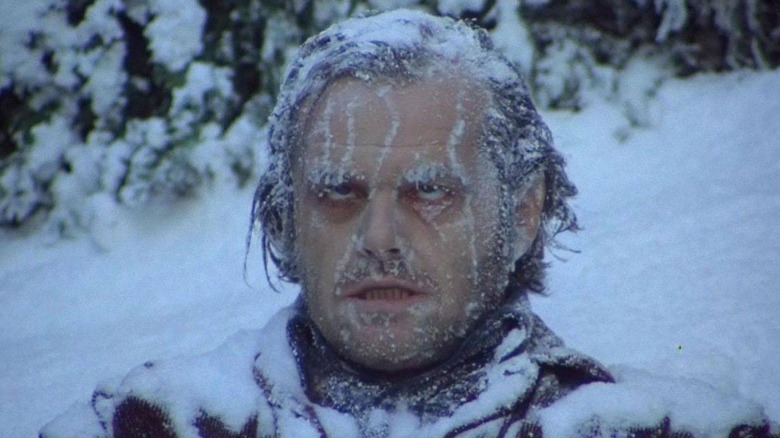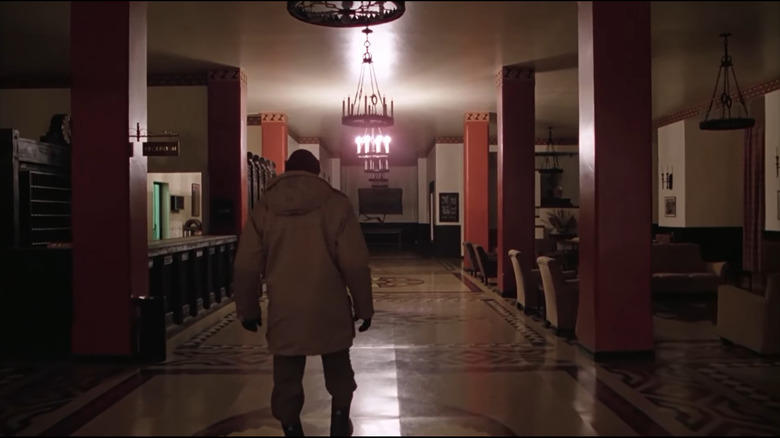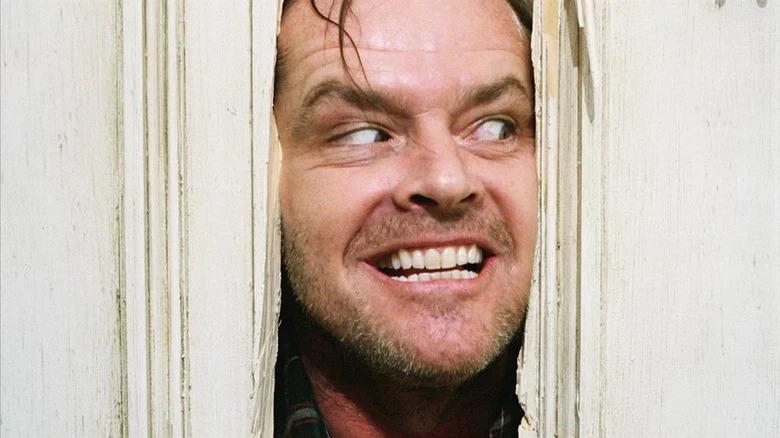Why Stanley Kubrick Decided To Scrap The Shining's Original Ending
Stanley Kubrick made a lot of changes to Stephen King's source material when making "The Shining." Rather than have protagonist Jack Torrance (Jack Nicholson) slowly spiral into insanity as he does in the book, Kubrick has Jack start off unhinged and only get worse from there. Whereas Danny's imaginary friend is presented in the book as a kid named Toby, in the movie, Danny is shown talking to his finger.
The biggest change from book to film was the ending. In the book, Danny and Wendy are saved by Dick Hallorann, the head chef of the hotel who rushes to the rescue when Danny telepathically messages him from across the country. In the movie, Hallorann also rushes back to the Overlook Hotel in an attempt to save the day, but instead is immediately killed by Jack. Turns out those psychic powers Hallorann had weren't all that helpful, because the clumsy, bleeding, head wound-suffering Jack was easily able to sneak up on him in an otherwise empty, quiet hotel.
The changes don't stop there. Whereas the book ends with Jack being lured to the boiler room and getting killed in an explosion that destroys the hotel, the movie has Jack die by getting lost in a maze and freezing in the cold. The movie ends with the hotel still intact, with the implication that this probably won't be the last tragedy that happens here.
When asked what went behind the choice to change so much from the source material, Kubrick explained: "To be honest, the end of the book seemed a bit hackneyed to me and not very interesting." When it came to adapting the book, his goal was "to extract the essential plot and to re-invent the sections of the story that were weak."
Too many changes from the book
Stephen King famously did not like Stanley Kubrick's adaptation, and many of us King fans hold a grudge against the director for the same basic reasons. Although Kubrick found the book to be "one of the most ingenious and exciting stories of the genre" he'd ever read, his casual declaration that he changed things because those sections of the original book were "weak" only rubbed salt in the wounds of fans who'd hoped to see some of their favorite scenes faithfully adapted.
When Kubrick said that "the characters needed to be developed a bit differently than they were in the novel," it's hard to not be a little be annoyed, because if there's one thing every fan of the book can agree on, it's that the book versions of Jack, Wendy, and Danny were far more complex and engaging than their movie counterparts. Jack's mental spiral in the book is tragic; in the movie it's non-existent. As he told Deadline about movie Jack: "All he does is get crazier. In the book, he's a guy who's struggling with his sanity and finally loses it. To me, that's a tragedy. In the movie, there's no tragedy because there's no real change."
Likewise, King found the change to Wendy disappointing: "She's basically just there to scream and be stupid," he told BBC, "and that's not the woman that I wrote about."
In Kubrick's defense
But for a movie that could only be two and a half hours long at most, these changes were likely for the best. Believably turning Jack from good to evil would've taken far longer than the movie had time for, so they made him crazy from day one. And because it wouldn't have been believable for book Wendy to have stuck around someone like movie Jack all these years, they changed her to someone who'd be easier for Jack to push around.
And as disappointing as it may have been for book fans to see Dick Hallorann drive all the way to the hotel just to immediately get killed with an axe, Kubrick may have had a point when he said it raised the stakes. As he told Michel Ciment, "I wanted an ending which the audience could not anticipate. In the film, they think Hallorann is going to save Wendy and Danny. When he is killed they fear the worst. Surely, they fear, there is no way now for Wendy and Danny to escape."
The chase sequence in the maze was also a change that made sense for switching over to a visual medium. The closest thing to the maze in the book were the animal topiaries in the garden, which moved whenever you weren't looking at them. (Basically the Weeping Angels, but in hedge animal form.) It was one of the scariest scenes in the book, but one that would probably look a little goofy on screen.
Ultimately, Kubrick was more concerned with making a movie that stood on its own, rather than just the movie version of a book. It was disappointing to those who loved the novel, but if the film's long-lasting success is any indication, Kubrick's approach has definitely paid off.


